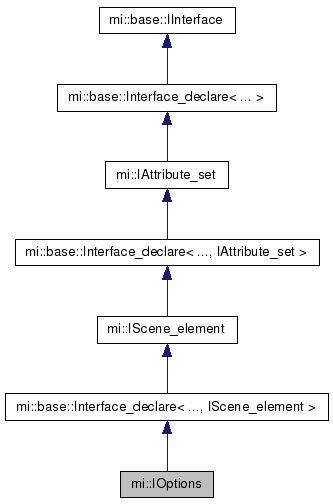A scene element that stores scene-specific settings. More...

Public Member Functions | |
| virtual Color_struct | get_contrast () const =0 |
| Returns the contrast for adaptive oversampling. More... |
|
| virtual void | set_contrast (const Color_struct &color)=0 |
| Sets the contrast for adaptive oversampling. More... |
|
| virtual Float32 | get_shutter_open () const =0 |
| Returns the time at which the camera shutter opens. More... |
|
| virtual void | set_shutter_open (Float32 shutter_open)=0 |
| Sets the time at which the camera shutter opens. More... |
|
| virtual Float32 | get_shutter_close () const =0 |
| Returns the time at which the camera shutter closes. More... |
|
| virtual void | set_shutter_close (Float32 shutter_close)=0 |
| Sets the time at which the camera shutter closes. More... |
|
Additional Inherited Members | |
 Public Types inherited from mi::base::Interface_declare< 0x4cac71c4, 0xd437, 0x4b9f, 0x83, 0x6d, 0xed, 0xb1, 0xe1, 0x42, 0xf1, 0x16, IScene_element > Public Types inherited from mi::base::Interface_declare< 0x4cac71c4, 0xd437, 0x4b9f, 0x83, 0x6d, 0xed, 0xb1, 0xe1, 0x42, 0xf1, 0x16, IScene_element >
| |
| typedef Interface_declare< id1, id2, id3, id4, id5, id6, id7, id8, id9, id10, id11, IScene_element > |
Self |
| Own type. More... |
|
| typedef Uuid_t< id1, id2, id3, id4, id5, id6, id7, id8, id9, id10, id11 > |
IID |
| Declares the interface ID (IID) of this interface. More... |
|
 Static Public Member Functions inherited from mi::base::Interface_declare< 0x4cac71c4, 0xd437, 0x4b9f, 0x83, 0x6d, 0xed, 0xb1, 0xe1, 0x42, 0xf1, 0x16, IScene_element > Static Public Member Functions inherited from mi::base::Interface_declare< 0x4cac71c4, 0xd437, 0x4b9f, 0x83, 0x6d, 0xed, 0xb1, 0xe1, 0x42, 0xf1, 0x16, IScene_element >
| |
| static bool | compare_iid (const Uuid &iid) |
Compares the interface ID iid against the interface ID of this interface and of its ancestors. More... |
|
A scene element that stores scene-specific settings.
There are three different types of options:
This class deals with the first of the three types.
These scene-specific settings are typically exposed as attributes; only a few of them are exposed via explicit methods of this interface. Note that the list of attributes below contains only general options that are supposed to be supported by all render modes. Render modes might support additional options which are not documented here, but in the corresponding section of [IPM]. Likewise, render-mode specific limitations in the support of the general options below is documented there.
section_plane_normal. This attribute is deprecated, use section_planes instead (which has precedence over this attribute here)."Section_plane" which describe sections planes that can be used to cull parts of the scene. A structure of type "Section_plane" has the the following members:true, also the geometry behind the section plane occludes incoming light. The default is false.attach_shader() etc. on mi::ICamera. If both MDL and MetaSL environment functions are present then the MDL settings have precedence.
|
pure virtual |
Returns the contrast for adaptive oversampling.
|
pure virtual |
Returns the time at which the camera shutter closes.
See mi::IOptions::get_shutter_open() for details on how this value is used.
|
pure virtual |
Returns the time at which the camera shutter opens.
The camera shutter opens at the time returned from this method and closes at the time returned by the method mi::IOptions::get_shutter_close(). If both times are equal, motion blur rendering is disabled; if the time returned by the method mi::IOptions::get_shutter_close() is greater than that return from this method, motion blur rendering is enabled. The normal range is (0, 1), which uses the full length of the motion vectors or motion vector paths. It can be useful to set both times to 0.5, which disables motion blur rendering but computes scene data at an offset of one half of the frame, which allows bi-directional post-motion-blur in an output shader. (The defaults are both 0.0, disabling any motion blur.)
|
pure virtual |
Sets the contrast for adaptive oversampling.
|
pure virtual |
Sets the time at which the camera shutter closes.
See mi::IOptions::get_shutter_open() for details on how this value is used.
|
pure virtual |
Sets the time at which the camera shutter opens.
See mi::IOptions::get_shutter_open() for details on how this value is used.